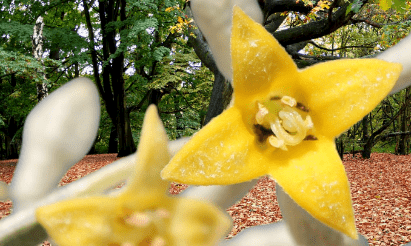It can grow up to 7 meters. The stem, buds and leaves are covered with silvery scales. Young branches are silvery and mature branches are brown. Leaves are alternate, lanceolate to oblong-lanceolate, 4 to 9 cm long and 1 to 2.5 cm wide with smooth margins. Flowers aromatic, in clusters of 1 to 3, 1 cm long and with a four-lobed cream-yellow cup. The fruits are soft and dry in texture. Seeds ripen in August and September. Flowers are hermaphrodite.
Elaeagnus angustifolia, commonly known as Russian olive or oleaster, is native to a vast region that spans from Southeast Europe to Western Asia. The natural habitat of Elaeagnus angustifolia includes:
- Eastern Europe: It is found in countries such as Romania, Bulgaria, and Ukraine.
- Western Asia: The species is native to regions in Western Asia, including parts of Iran, Iraq, Turkey, and the Caucasus.
- Central Asia: Elaeagnus angustifolia is also present in various Central Asian countries, such as Kazakhstan, Turkmenistan, and Uzbekistan.
- China: It extends into parts of China, particularly in the northwestern regions.

In addition to its native range, Russian olive has been introduced and cultivated in other parts of the world, including North America. It is sometimes planted for erosion control, as it is tolerant of harsh conditions, such as poor soil and drought. However, Russian olive is considered invasive in some areas, and its presence can have ecological impacts on native ecosystems. Due to its ability to thrive in diverse conditions, it can be found in a variety of habitats, including dry slopes, riverbanks, and disturbed areas.
How tall do elaeagnus angustifolia get?
Elaeagnus angustifolia, commonly known as Russian olive or oleaster, is a deciduous shrub or small tree that can vary in size depending on environmental conditions and growing conditions. Generally, Russian olive can reach a height of 15 to 30 feet (4.5 to 9 meters) and often has a similar spread. However, some individuals may stay smaller, especially in less favorable growing conditions.
The plant has a dense and bushy growth habit with narrow, silver-green leaves. It produces fragrant yellow flowers and silver-scaled fruit. Russian olive is known for its adaptability to various soil types and its tolerance of drought and poor soil conditions.
It’s important to note that Russian olive has been considered invasive in certain regions, including parts of North America, where it has been introduced. In these areas, its aggressive growth habit can lead to ecological problems, as it may outcompete native vegetation. Before planting Elaeagnus angustifolia, it’s advisable to check with local authorities or extension services to ensure it is suitable for your region and won’t pose a threat to local ecosystems.
